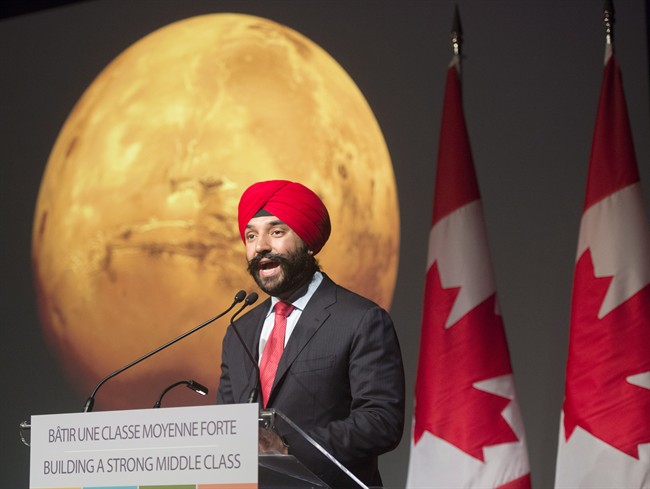LONGUEUIL, Que. – Money earmarked for space development in this year’s federal budget will go to two projects that could have lasting impacts on Earth and beyond, the federal government announced Thursday.

One of them involves a radar instrument that would be used to study the surface and subsurface of Mars.
The other looks at the applications of quantum technology in space and will be overseen by the Institute for Quantum Computing at the University of Waterloo.
READ MORE: PM Justin Trudeau gives reporter quick lesson on quantum computing during visit to Waterloo

That project involves quantum encryption, which uses highly advanced computing technology to create virtually unbreakable security codes.
In announcing how the $80.9 million would be spent over five years, Economic Development Minister Navdeep Bains told staff at the Canadian Space Agency headquarters near Montreal that space innovation is a smart investment for Canada.
In addition to two new Canadian astronauts to be introduced in the coming months, Bains said a recently convened space advisory board is expected to report back this summer with a long-term plan for the sector, which employs about 10,000 people.
“We want to have a thoughtful, insightful, long-term plan when it comes to space,” Bains told reporters.
The radar instrument, identified as a necessary tool by Canada’s space partners, would be developed for a future orbiter mission to the red planet and would help in developing a high-resolution map of the surface as well as identifying water resources at shallow depths.
READ MORE: Final candidates unveiled as Canada searches for 2 new astronauts

That geological data could provide invaluable information for future long-term space missions to Mars, but the tool could also have Earth applications.
Gilles Leclerc, director general of space exploration at the space agency, said the instrument is different from contributions such as an X-ray spectrometer on the Curiosity rover and a meteorological station on the Phoenix spacecraft that were both part of Mars-bound missions
“This time, it would be different for us because we’d be mapping the surface from orbit,” Leclerc said.
Leclerc said discussions are ongoing with NASA to have an instrument ready for a launch by 2022 or 2024.
Bains said the quantum investment should help solidify Canada’s standing in the field.
“Canada is considered a world leader in quantum, and this area has incredible potential for growth and job creation for years to come,” he said, adding there are earthly spinoffs too.
“It could eventually provide Canada with more secure communications in many sectors — banking, transportation and information technology.”
In the 2016 budget, $379 million was set aside to secure Canada’s partnership in the International Space Station until 2024 and another $30 million for a four-year partnership on a project with the European Space Agency.
Joining Bains at CSA headquarters was Transport Minister Marc Garneau, the first Canadian in orbit and a former CSA president who returned to headquarters for the first time in an official capacity since quitting to pursue politics in 2006.
- Posters promoting ‘Steal From Loblaws Day’ are circulating. How did we get here?
- Video shows Ontario police sharing Trudeau’s location with protester, investigation launched
- Canadian food banks are on the brink: ‘This is not a sustainable situation’
- Solar eclipse eye damage: More than 160 cases reported in Ontario, Quebec



Comments